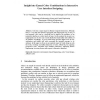Free Online Productivity Tools
i2Speak
i2Symbol
i2OCR
iTex2Img
iWeb2Print
iWeb2Shot
i2Type
iPdf2Split
iPdf2Merge
i2Bopomofo
i2Arabic
i2Style
i2Image
i2PDF
iLatex2Rtf
Sci2ools
HCI
2009
2009
Insight into Kansei Color Combinations in Interactive User Interface Designing
Color has a major impact on Human Computer Interaction. Although there is a very thin line between appropriate and inappropriate use of color, if used properly, color can be a powerful tool to improve the usefulness of an interactive interface in a wide variety of areas. On the contrary the excessive or inappropriate use of color can severely hinder the functionality and usability of an interface accordingly. A good visual design provides higher level of user satisfaction and further aids with conveying the intended message to its audience. In this paper we focus on one requisite aspect of visual design as such the Color, revealing one hidden dimension of color; Affectivity, by acquiring prospective user's concealed color aesthetic preferences, employing Kansei Engineering Assessing System with respect to interactive Interfaces.
| Added | 18 Feb 2011 |
| Updated | 18 Feb 2011 |
| Type | Journal |
| Year | 2009 |
| Where | HCI |
| Authors | K. G. D. Tharangie, Shuichi Matsuzaki, Ashu Marasinghe, Koichi Yamada |
Comments (0)

